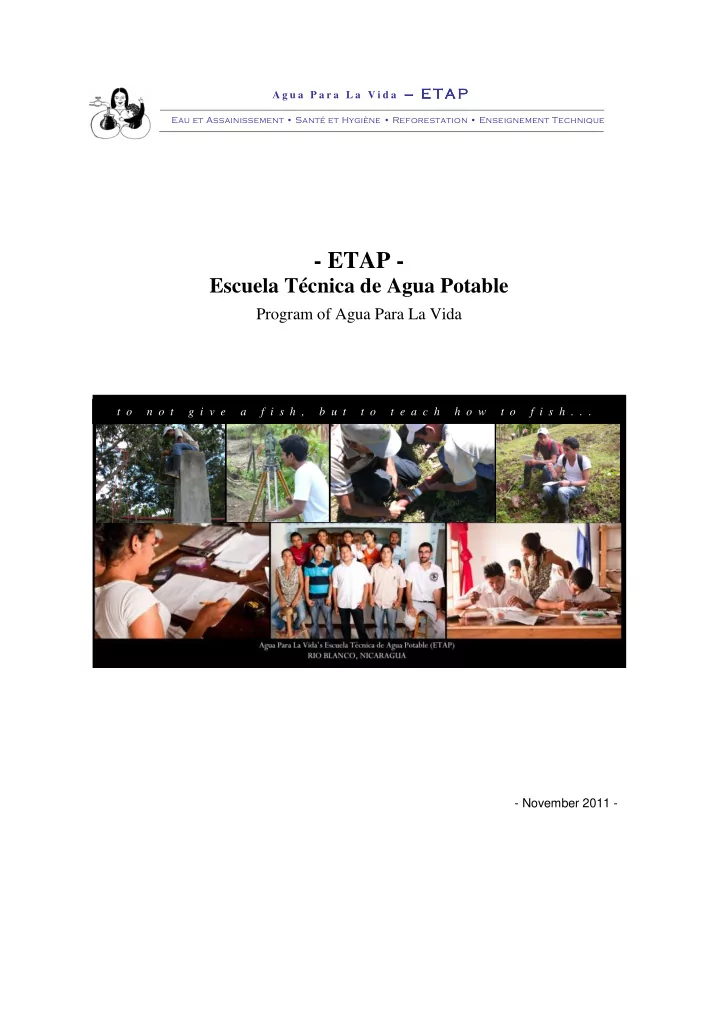

A g u a P a r a L a V i d a � � � � � � � � � � � � � � � � � � � � � � � � � � � � � � � � ���������������������������������������������������������������������������������� - ETAP - Escuela Técnica de Agua Potable Program of Agua Para La Vida � t o n o t g i v e a f i s h , b u t t o t e a c h h o w t o f i s h . . . - November 2011 -
A g u a P a r a L a V i d a � � � � � � � � � � � � � � � � � � � � � � � � � � � � ��������������� ���������������������� ����!����� ������������� �����������!���������� C ONTENT I - ORGANIZATION INFORMATION.......................................................................................................... 3 1.1 I NFORMATION ......................................................................................................................................... 3 1.2 C ONTACT I NFORMATION ........................................................................................................................ 3 1.2.1 United States...................................................................................................................................... 3 1.2.2 Nicaragua.......................................................................................................................................... 3 II - CONTEXT ................................................................................................................................................ 4 III - DESCRIPTION OF AGUA PARA LA VIDA ....................................................................................... 4 3.1 APLV: M ISSION AND ACHIEVEMENTS .................................................................................................... 4 3.2 APLV’ S S USTAINABLE A PPROACH ......................................................................................................... 5 3.2.1 Objectives .......................................................................................................................................... 5 3.2.2 Six integrated components................................................................................................................. 6 3.2.3 APLV’s method.................................................................................................................................. 7 IV - DESCRIPTION OF THE PROJECT: ETAP........................................................................................ 9 4.1 P ROJECT O VERVIEW ............................................................................................................................... 9 4.2 G ENERAL SKILLS ACQUIRED .................................................................................................................10 4.3 S ELECTION PROCESS .............................................................................................................................10 4.4 E DUCATION M ETHODOLOGY & S YLLABUS ...........................................................................................10 4.4.1 ETAP’s approach ............................................................................................................................10 4.4.2 Curriculum ......................................................................................................................................11 4.4.3 Module Skills and Content...............................................................................................................13 4.5 B ENEFICIARIES .....................................................................................................................................16 4.6 P LANNING .............................................................................................................................................17 4.7 B UDGET ................................................................................................................................................18 2/20
A g u a P a r a L a V i d a � � � � � � � � � � � � � � � � � � � � � � � � � � � � ��������������� ���������������������� ����!����� ������������� �����������!���������� I - O RGANIZATION I NFORMATION 1.1 Information A GUA P ARA L A V IDA www.aplv.org aplv@aplv.org 1.2 Contact Information 1.2.1 United States Charlie Huizenga 2311 Webster Street Berkeley, CA 94705 charlie@aplv.org 510-914-1988 1.2.2 Nicaragua Carmen González, Nacional Coordinador, Managua carmen@aplv.org (505) 89 01 60 77 Cecilia Santonja and Denis Barea, ETAP Teachers and Principals, Río Blanco etap@aplv.org (505) 84 95 35 35 3/20
A g u a P a r a L a V i d a � � � � � � � � � � � � � � � � � � � � � � � � � � � � ��������������� ���������������������� ����!����� ������������� �����������!���������� II - C ONTEXT In Nicaragua, the coverage level of potable water and sanitation services is low: it is estimated that 52% of the rural population live without access to clean water or adequate sanitation. This situation is even more acute in indigenous communities, where 80% of the population lacks basic services. This situation impacts directly on the health of the population - nearly 80% of health problems (diarrhea, parasites, conjunctivitis, and skin disease, among others) in the rural population can be attributed to lack of access to safe water. Moreover, the task of carrying water from the source to the house falls on women and children and often requires several hours per day. The ability of the Nicaraguan government and its citizens to meet the demand for drinking water and sanitation is limited not only by a lack of financial resources but also a lack of Nicaraguan professionals able to design and build such systems. That knowledge might in principle be provided by local engineers but they are costly, too few and in any case the planning, design and building supervision needed for these village systems turns out to require a mix of technical training and familiarity with farmers and more generally rural life. For these reasons, in addition to its own drinking water projects, the NGO Agua Para La Vida (APLV) has created a Drinking Water Technical School called ETAP - Escuela Técnica de Agua Potable - with the goal of teaching young people from rural areas how to design, build and maintain rural drinking water and sanitation projects. Graduates from the school receive a nationally accredited degree as Technicians in Design and Management of Rural Drinking water and Sanitation Systems . This training is completely free for students, enables them to improve their economic status and gives them the skills necessary to be involved in the development of their own country. III - D ESCRIPTION OF A GUA P ARA L A V IDA 3.1 APLV: Mission and achievements Agua Para La Vida is an international non-profit organization founded in 1987 with the aim of improving the living standards of rural communities in Nicaragua. The organization has a 24 year history of successful integrated projects of gravity-flow drinking water systems, sanitation, health education and environmental management for rural communities exclusively in Nicaragua. To date, APLV has designed and installed 72 projects that serve more than 20,000 people with clean drinking water. The organization is registered as an NGO in the US, Nicaragua and France and receives funding from foundations and individuals. El Carrizal Project - 2010 4/20
More recommend